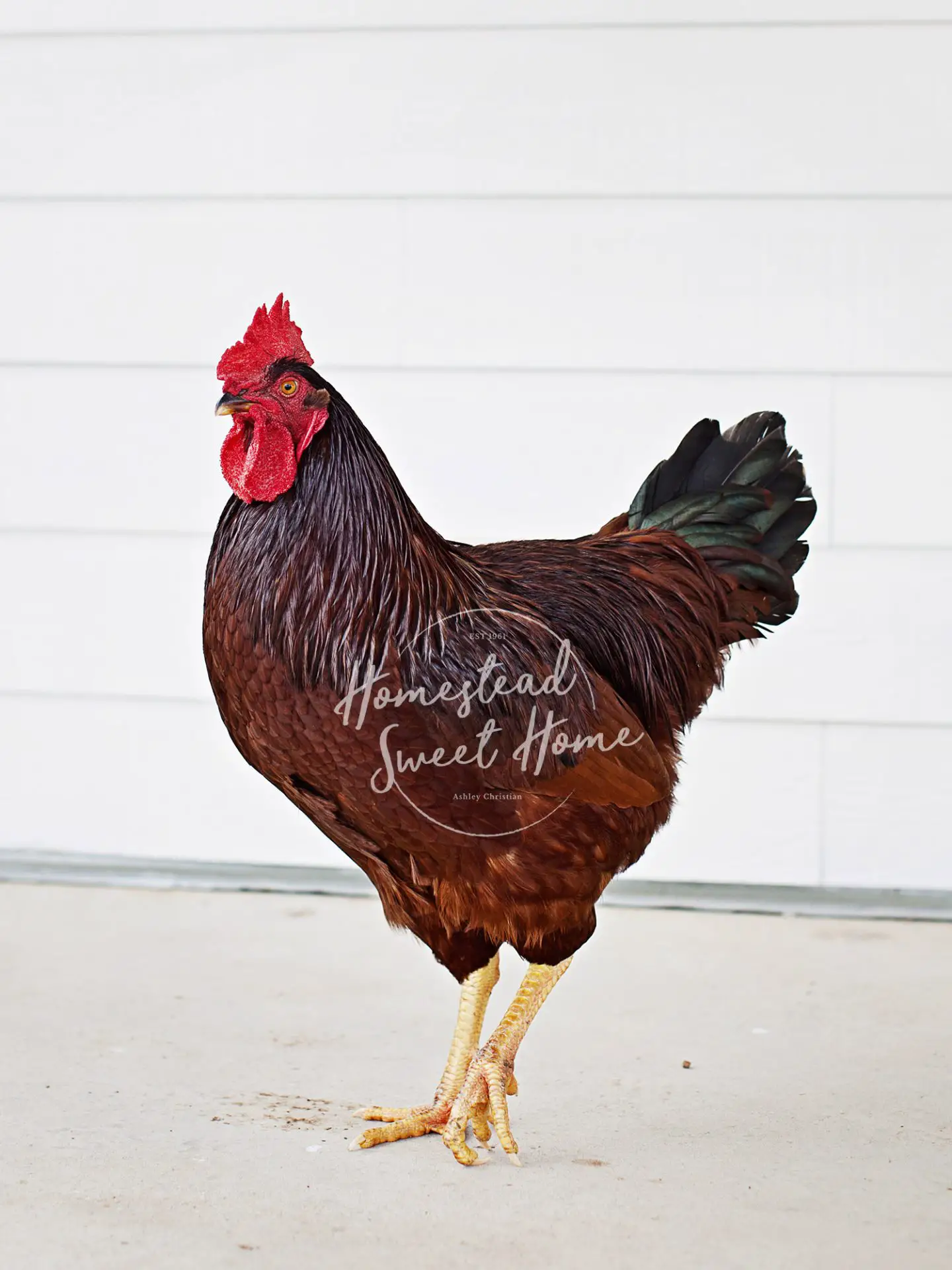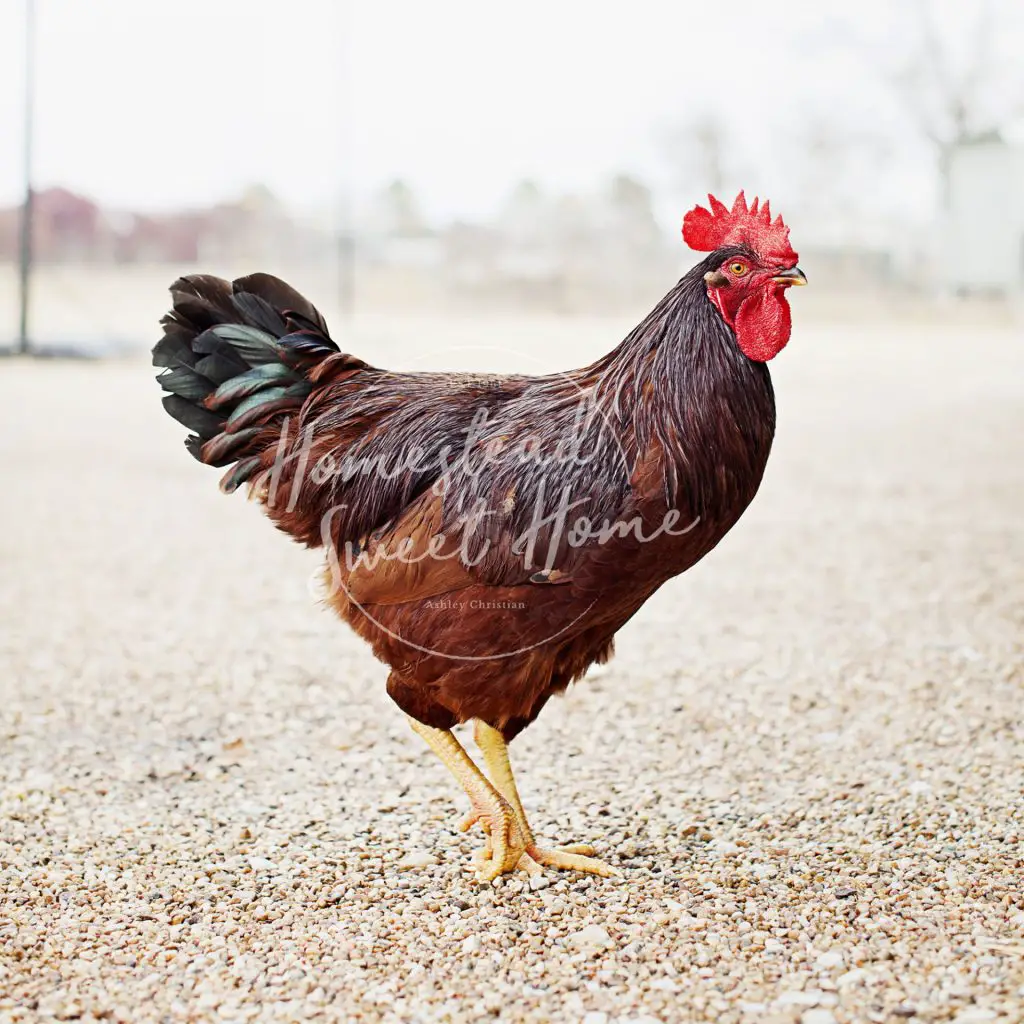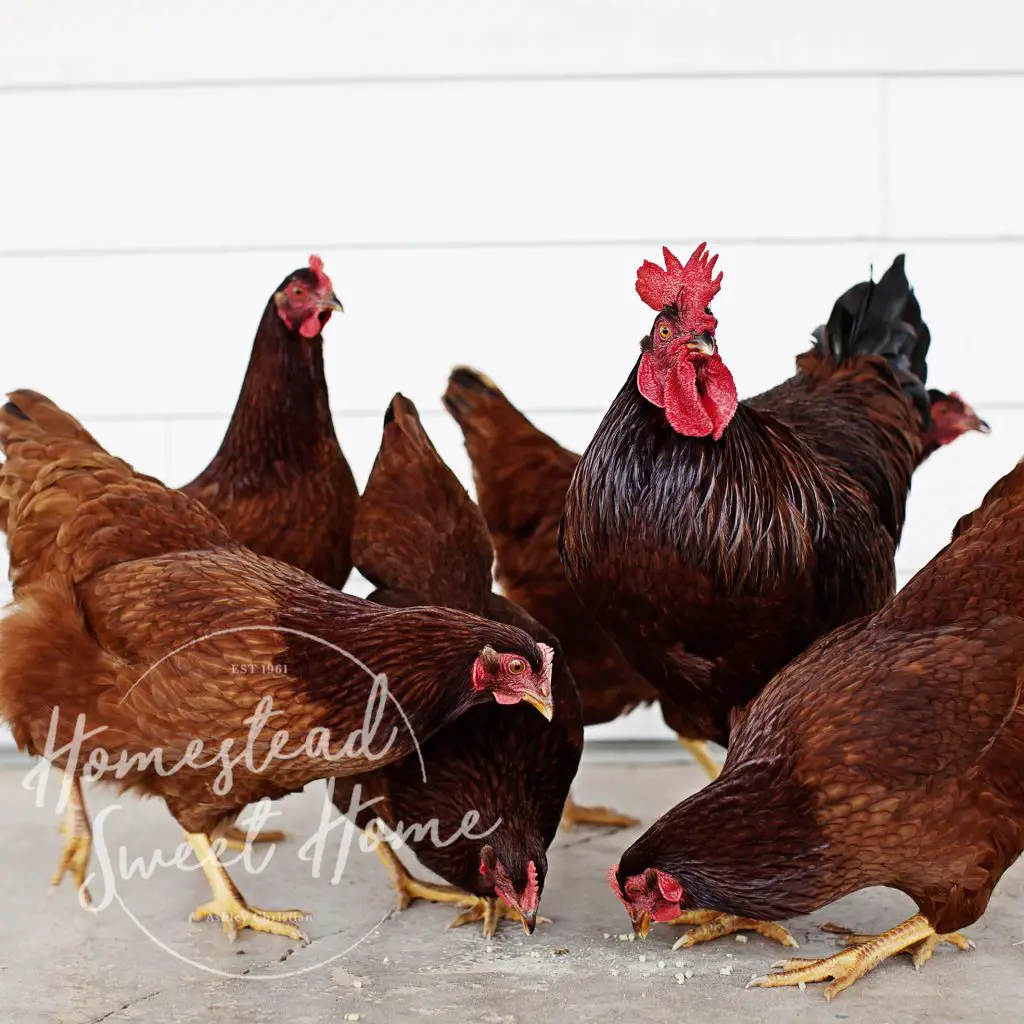Rhode Island Red – Pros and Cons

Rhode Island Red Quick Facts
- Known for: high egg production
- Temperament: very friendly
- Eggs: 200-300 large light brown eggs each year
- Meat: good meat production—reaches maturity at 19 weeks with 8.5lb males and 6.5lb females
- Climate: Excellent cold tolerance and good heat tolerance
- Broodiness: not very likely to sit on eggs
Rhode Island Red Overview
The Rhode Island Red is one of the most popular breeds of chicken because they thrive in nearly any climate, are excellent egg layers, and are a very friendly breed. If you’re just getting started with chickens or looking for a great bird for your backyard coop, you can’t go wrong with the Rhode Island Red. The Rhode Island Red is a great breed for anyone looking for an excellent egg layer that is tolerant to most climates. They are also very friendly and make great pets. However, the roosters can be aggressive and the hens are not as motherly as other breeds.
Pros and Cons of Rhode Island Reds
- Pros: Excellent egg layers, good meat production, and weather hardy
- Cons: Roosters can be aggressive, hens are not very motherly
Rhode Island Red Appearance
- Size: Extra Large birds 6.5lb females and 8.5lb males
- Color: Mahagony red with yellow skin
- Egg Color: Rhode Island Reds eggs are light brown in color.
Rhode Island Red’s coloring is STUNNING! Their feathers glisten like the sun with hues of dark brown, crimson, and deep emerald green. Look closely and you will see the brilliant coloring of these amazing birds.

Rhode Island Red Egg Production
Rhode Island Reds are known for their egg production and will lay somewhere between 200-300 eggs per year. There is no farm breed that lays as well as the Rhode Island Red. Hens will reach maturity at 19 weeks and you can expect them to begin laying soon after. Their eggs may be initially tiny with a beautiful medium brown color. At around six months old, their eggs will grow from medium to extra large or even jumbo eggs that have strong whites that maintain their form and brilliant orange yolks.
Keep their coop and run clean to maintain birds that are healthy and laying well. Provide them with a separate bowl of oyster shells or crushed eggshells to feed at will. These supplements will give them the added calcium they need to lay well and stay healthy.
Rhode Island Red Meat Production
Rhode Island Reds are not fast-growing meat birds and will take up to 2-years to reach their full weight. They are primarily a heritage egg-laying breed. If you’re looking for a fast-growing meat bird, Rhode Island Reds are not your ideal choice. However, their meat is considered some of the best you can get. The breast and thigh meat are both dark and juicy with a fine texture.

Rhode Island Red Broodiness
Rhode Island Reds are not very broody, meaning they are not very likely to sit on a cluck of eggs for 21-days to incubate their fertilized eggs. If you would like to hatch Rhode Island Red eggs and don’t have any broody hens, you can purchase an incubator that controls the temperature and humidity and hatch the eggs yourself. Rhode Island Reds are also not the best choice for a mother hen because they will neglect their young once hatched. Rhode Island Red chickens have broody tendencies but only every so often.
Rhode Island Red Temperament
Rhode Island Reds are one of the most friendly breeds. They are very docile and get along well with children. Rhode Island Reds make great pets because they like people, enjoy being around their owners, and aren’t skittish or flighty like some breeds can be. They will happily follow you from one end of the yard to the other. Rhode Island Reds are a joy to have around your homestead or backyard farm.
Rhode Island Reds are peaceful, alert, friendly, beautiful, and good foragers when allowed to free-range. They are quicker than other breeds to run for cover when aerial predators begin stalking them. They are also very reliable to return to the coop before dark each evening.
The roosters can be aggressive and this seems to be the Rhode Island Red’s major con. If you can selectively breed for less aggressive roosters, that can help. On the upside, having an aggressive rooster means they are excellent at protecting their flock from predators. The hens are kind and loving and enjoy their snuggle time. They’re not beggars for food or treats, but rather lovers of affection. They may start out a little skittish but can warm up over time.

Rhode Island Red Noise Level
Rhode Island Reds can be talkative and a little sassy. They love to interact with people and will cluck and squawk at their owners. They are not excessively loud, but not exactly quiet either. If you live in a close space with neighbors who don’t enjoy chicken sounds, the Rhode Island Red may not be the right breed choice for you. Then again, you can always sweeten the deal by offering them some of your beautiful brown eggs.
They are a little noisy when nesting, which can be helpful if you would like to be alerted to eggs in the nesting box. This may be an issue depending on your neighborhood rules. When the other hens enter the coop while a Rhode Island Red is nesting, they can be extra noisy.
Rhode Island Red Care
These birds typically live about 5 years, however, hens only lay well for about 3 years, then their egg production will begin to decline. To keep your Rhode Island Reds healthy, be sure to keep their coop and run clean.
Because they are such prolific egg layers, they will also use extra calcium for healthy eggs shells. You will need to provide them with a separate bowl of crushed oyster shells or crushed eggshells to keep their calcium levels at a healthy level. Chickens naturally know how to regulate their own calcium intake and will consume the proper amount they need. Because too little, or too much calcium can be bad for chickens and even lead to death, it’s important to not mix the calcium in their food and instead keep it in a separate bowl so they can regulate themselves.
To learn more about how to take care of chickens, read our Ultimate Guide to Taking Care of Chickens.

Rhode Island Red Housing
Rhode Island Reds don’t require a ton of space but should have at least four square feet per bird inside the coop and an additional fifteen square feet outside. The Rhode Island Red hen is not as active as some of the other breeds, so this makes the breed an excellent choice for backyard chickens if you have limited yard space.
Reds, on the other hand, are strong birds who can get ugly to each other in a limited space with a little area — thus more room is preferable. Rhode Island Reds require 8 inches of perch space on average. During the summer heat, they will like to spread out a bit, but in winter they will all stack together to keep warm.
Nesting boxes should be a 12×12 inch cube or similar in size. If you provide them with too much room, they will combine together, resulting in broken eggs.
Feeding Rhode Island Reds
You may give your hens as much free-roaming space to eat plants and bugs as you can safely provide them. They’ll also enjoy kitchen scraps (though there are some that are harmful, we’ll list them for you.) Giving them this variety will not only help you save money on food but will also keep your fowl healthy and entertained.
Your chickens will need additional food, even if they get a varied or free-range diet. This feed will account for the majority of the diet for some birds with less space to wander. There are several types of feed available to help your hens progress through their various stages of development from chicks to laying hens. Around 18 weeks, Rhode Island Reds should be fed layer feed that is 16 percent protein and fortified with calcium for strong eggs. It’s suitable for feeding at around 18 to 20 weeks of age when your hens begin laying eggs. In a mixed flock, roosters can also use this feed.
Chickens don’t have teeth, so they need grit to break down their food. Grit can be anything from sand to a mixture of ground walnuts or gravel found on the road. Starter-only fed chicks do not need any grit until you start giving them goodies or allow them to free-range. If your hens are free-ranging, they will most likely acquire all of the sand or pebbles they need on their own, so you won’t have to offer any extras. However, if your birds are kept in a grassy yard that is not fenced in, we recommended providing them with a bowl of grit.
Chicken Scratch is a mix of several whole grains that stimulates pecking behavior, which is good for reducing stress in chickens. It’s not a substitute for their normal feed, but it’s an excellent addition for chickens kept in a yard because it keeps them entertained and happy.
Chicken Treats: You don’t HAVE to feed your chickens treats, but it’s a lot of fun! Mealworm and black soldier fly larvae are great snacks for chickens that you can buy from the feed store. We’ve even grown our own simple mealworm farm in pine shavings before!
Chickens will enjoy your kitchen and garden waste, which is a healthy component in their diet and will keep them entertained and happy. Chances are that most scraps are safe to feed chickens, however, there are a few that you should avoid since they can make your birds sick or even kill them. Do not feed your Rhode Island Reds avocados, dried beans, junk or rotten food, green potato skins, citrus, onions, or tomato or potato leaves from the garden.
What is it like to own a Rhode Island Red?
Rhode Island reds are very docile, friendly, and talkative. If you have a mixed breed flock they will land somewhere in the middle of the pecking order. The roosters tend to be aggressive, so select the most docile roosters and cull the rest. This will result in breeding practices that lead to more docile roosters as they breed.
If you have an aggressive rooster, you will want to be especially careful around children as the roosters are heavy birds and may spar at kids and leave deep scratches. Unfortunately, we have had this happen with several Rhode Island Red Roosters and had to dispatch them. We even named one after my grandfather Warren, so I recommend not naming your chickens after family members!

Rhode Island Red Breed History
The Large Fowl Rhode Island Red is one of the oldest known chicken breeds and was developed mainly in Rhode Island and Massachusetts during the mid-nineteenth century. The first birds were produced in Little Compton, RI, using a Black Breasted Red Malay cock obtained from England. The breed has been a member of the American Poultry Association since 1904.
The Rhode Island White is a dual-purpose bird that was developed to survive the chilly New England winters and still produce massive egg yields, as well as being able to dress out nicely as a meat bird. While the names and origins remain the same, according to the American Poultry Association, the Rhode Island White is a distinct breed from the Rhode Island Red.
The Rhode Island Red is available in both large fowl and bantam size, as well as rose comb types. You can also find a heritage breed of Rhode Island Red which is a good dual-purpose chicken and the production breed of Rhode Island Red which is primarily an egg-laying breed.
Summary
Rhode Island Red Chickens are a very popular choice for people looking to start an egg-laying flock. Rhode Island Reds can produce up to 300 eggs in a single year! For the most part, their docile personalities make them a joy to keep around the backyard farm. Rhode Island Reds do well in a variety of climates, but they are especially suited to colder environments. If you’re looking for an all-around great backyard chicken breed to give you plenty of eggs, the Rhode Island Red is one of the most popular!
Do you own Rhode Island Red chickens? Let us know in the comments below what your experience has been.

One Comment
my teacher read this while i scrolled by and wasnt suprised that i was looking at chickens